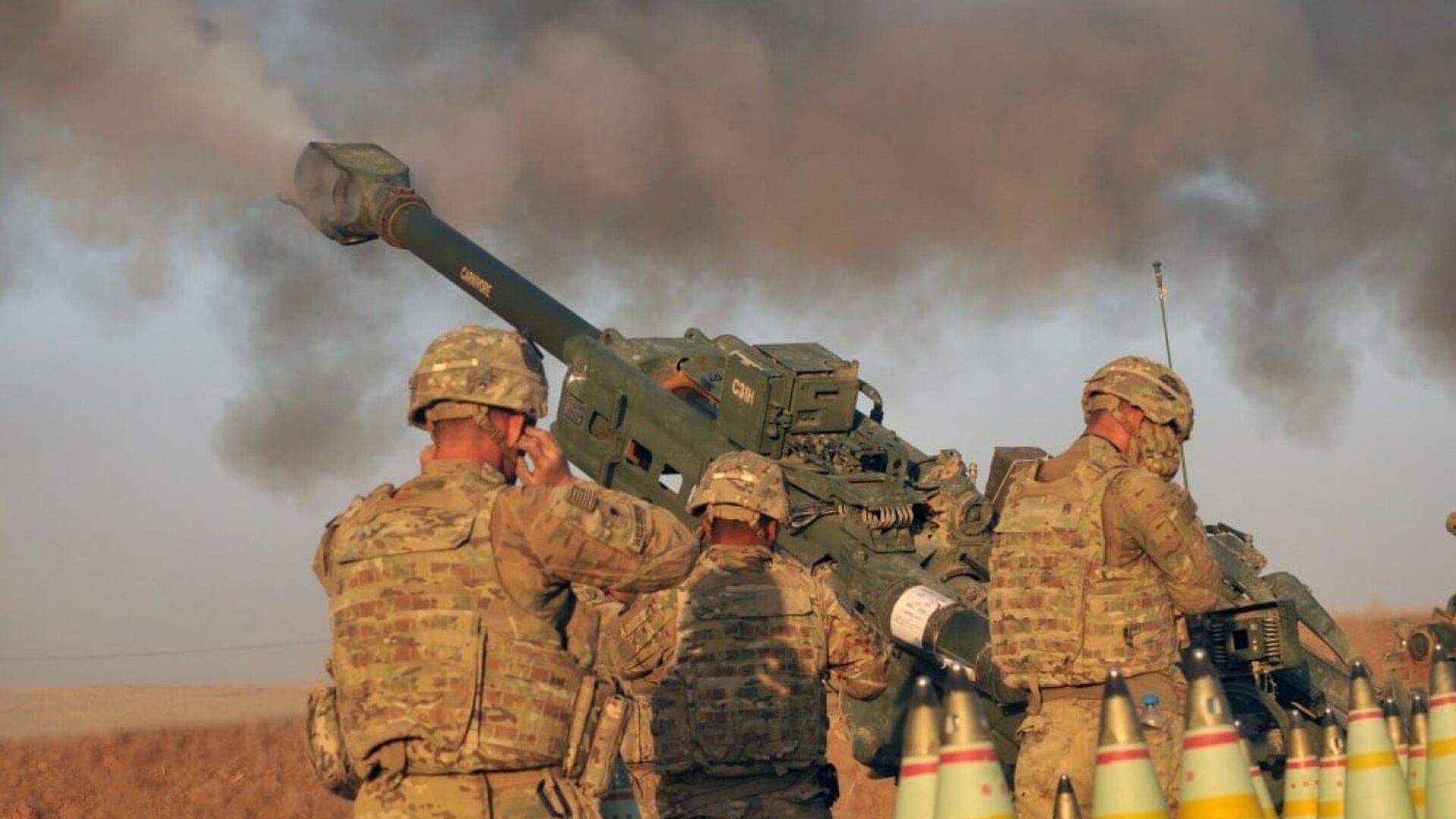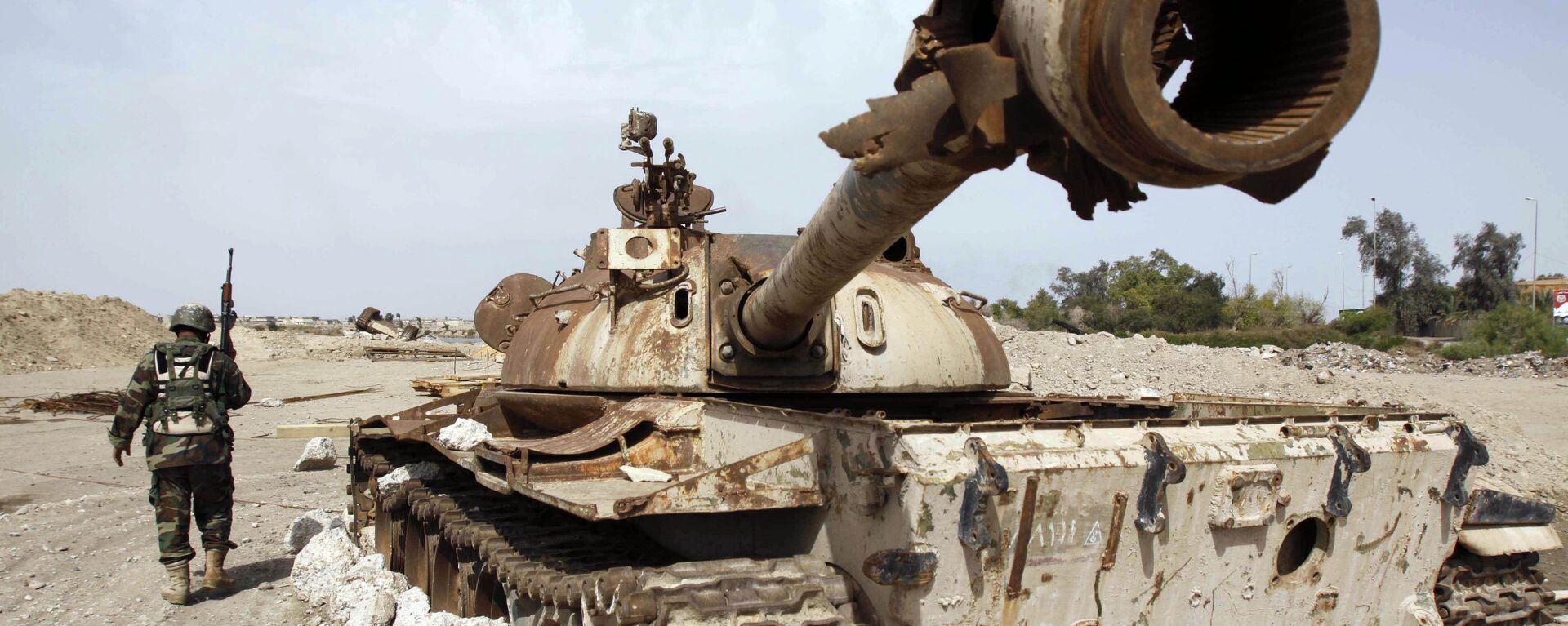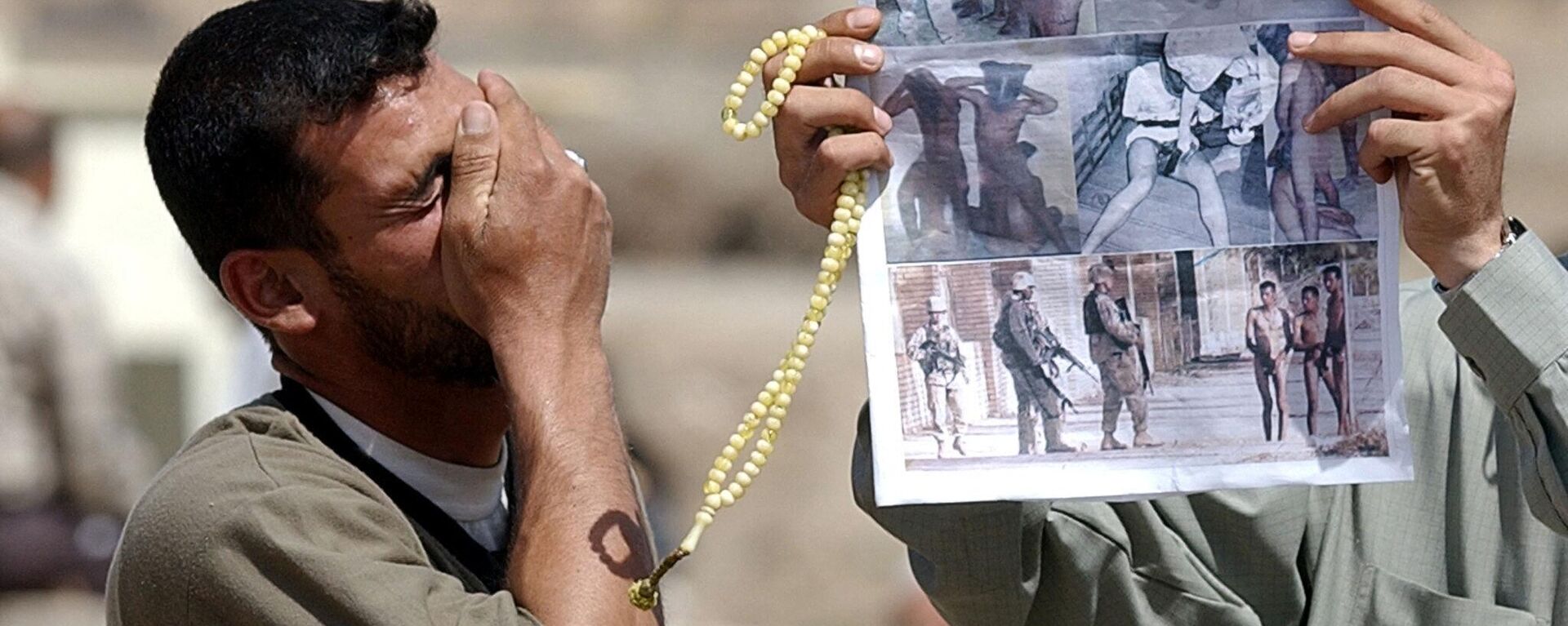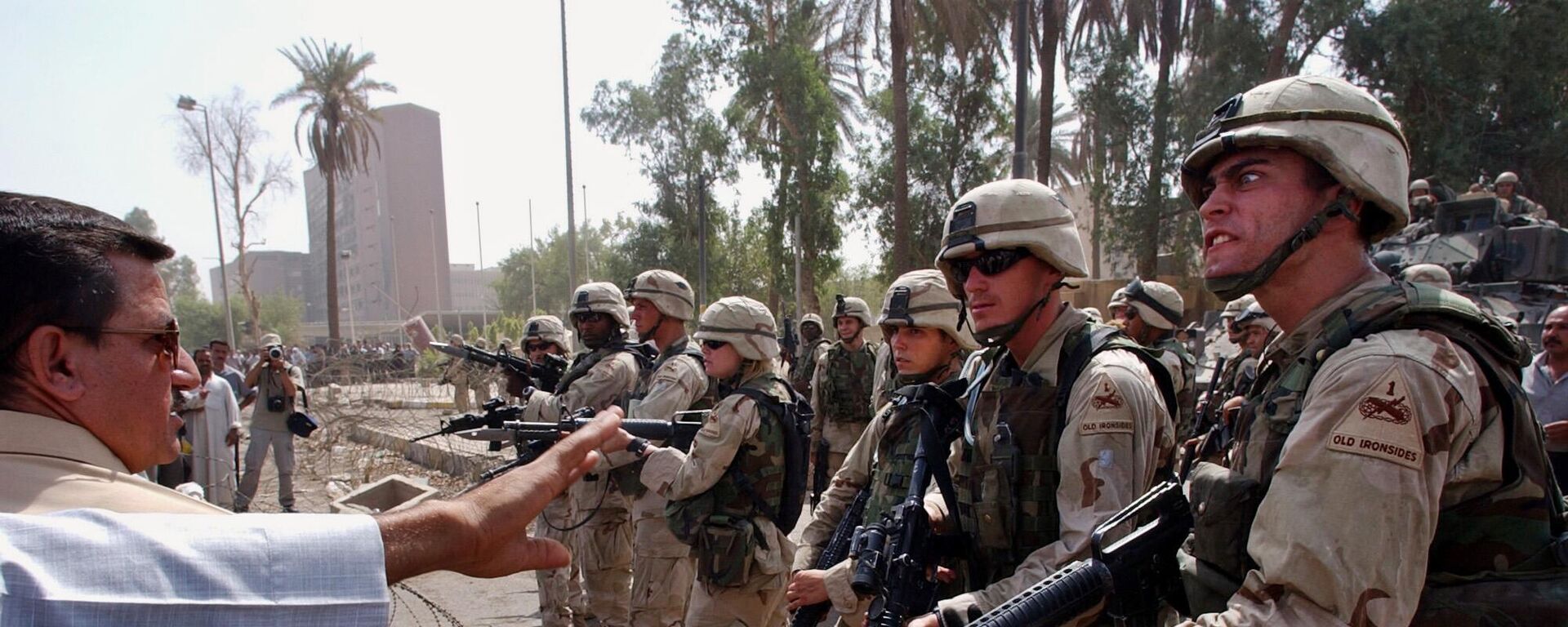https://sputnikglobe.com/20230319/abu-ghraib-horrors-of-us-occupation-of-iraq-1108563125.html
Abu Ghraib: Horrors of US Occupation of Iraq
Abu Ghraib: Horrors of US Occupation of Iraq
Sputnik International
Abu Ghraib was a prison in the Iraqi city of the same name, located 32 kilometers west of Baghdad. The first buildings were constructed by a British contractor in the 1950s and were designed from the outset as a place of detention.
2023-03-19T10:21+0000
2023-03-19T10:21+0000
2023-03-19T10:21+0000
20 years since us invasion of iraq
iraq
iraq war
us military
us
saddam hussein
prisons
https://cdn1.img.sputnikglobe.com/img/106983/96/1069839660_0:75:1484:910_1920x0_80_0_0_8e7659ee04c0b15edf267e8026dedd90.jpg
Under Saddam HusseinDuring Saddam's leadership, the Mudiria al-Amn al-'Amm, or Directorate of General Security (DGS), operated the high-security prison where, according to Western media reports, mass torture and execution of political prisoners of the government took place.In fact, however, there was no evidence that the prison was a political and not a conventional one. The latter is suggested by a mass amnesty for common law prisoners who were paroled in 2002, just before the Western coalition invaded Iraq.There is also little evidence of mass executions, as research on mass graves near the prison has confirmed the burial of 993 prisoners over the entire period. However, according to Western claims, between 4,000 and 12,000 prisoners were executed in "Saddam's torture center" in 1984 alone, and about 1,500 in 1997.During US-Led International Coalition InvasionIn 2003, after the fall of Saddam Hussein's government, the Americans inherited an already empty prison. With its convenient location and ready-made infrastructure, Abu Ghraib became the main detention center for Iraqi prisoners of war and political prisoners.Until August 2006, the prison was used jointly by coalition forces and the Iraqi government. Convicted criminals served their sentences in the block under the full control of the local authorities. The rest of the prison was under the control of US Armed Forces and was used as a forward operating base and correctional facility.Under the control of US forces, Abu Ghraib had several categories of detainees:Thus, during the US presence, Abu Ghraib became a place of detention for prisoners from a broad spectrum of the predominantly local population, held on arbitrary grounds and suspicion, in violation of the "detention and imprisonment" principles of the Geneva Convention.Exposing TortureIn the spring and summer of 2003, human rights organizations that went to Iraq with the US began to draw attention to the use of violence by the occupying forces against Iraqi prisoners of war and detainees.In November 2003, Abdel Turki, the US-appointed human rights supervisor for the Iraqi interim administration, reported to Paul Bremer, head of the Coalition Provisional Authority, numerous cases of torture and abuse of detainees in the country's prisons, including Abu Ghraib. As Turki later recalled, there was no response.Word of what was happening at Abu Ghraib got out, and the news spread quickly. One such report in the spring of 2004 nearly sparked a large-scale popular uprising in Baghdad.It all started when a letter written by one of the female prisoners began to circulate and ended up outside the prison. The gist of the message was that the women imprisoned at Abu Ghraib were constantly being abused by the Americans, and sometimes by loyal Iraqi guards, and that many of the women ended up pregnant because of their abusers.A copy of the letter was distributed by hand and posted on the walls. In one Baghdad mosque, the letter was read during a sermon.As a result, popular resistance to the coalition intensified in Iraq. Unarmed people stoned US military convoys, shouted anti-American slogans, and attacked military vehicles. And in some parts of Baghdad, there were armed ambushes.But the investigation into the abuse of prisoners at Abu Ghraib did not begin because of this, but because of the curiosity of Joseph Darby, an American military police officer who, in December 2003, borrowed a CD from his colleague Charles Greiner for his own use. The CD contained, among other things, gruesome evidence of torture and abuse of prisoners in the prison. Three weeks later, he reported this to his superiors.On January 13, 2004, a command investigation was opened against 17 members of the military for abuse.The commander of the coalition ground forces in Iraq, Ricardo Sanchez, appointed Major General Antonio Taguba to lead the investigation into the torture at Abu Ghraib.On February 23, 2004, 17 military personnel, including a battalion commander, company commander, and 13 military police privates, were suspended from duty pending the investigation.On March 20, a spokesman for US coalition forces announced that preliminary investigations had resulted in criminal charges against six soldiers. Hearings in the case began on April 9.None of the official statements at the time were much of a secret, because the information was softened as much as possible - it was about "abuses," "abuse of power," and "antics of individuals."In early to mid-April, however, CBS obtained a copy of Taguba’s report, along with all of the photos. US authorities tried to stop reporters from publishing this information, but when they learned that famed journalist Seymour Hersh knew what was going on and was preparing to publish it in The New Yorker, they began to act proactively.On April 28, 2004, CBS aired a report on the investigation, accompanied by some pictures of torture of detainees (some of the most innocuous) - and the report soon appeared in media around the world. The information was presented in a very softened form, with references to the Taguba Report - what was happening were the antics of individual sadists and abusers who had somehow infiltrated the US forces, and it was an isolated violation, not a systematic practice.The prison authorities and Brigadier General Janis Karpinski were blamed for failing to educate the guards about the provisions of the Geneva Convention regarding the treatment of prisoners of war and detainees.Staff Sergeant Ivan Frederick, Sergeants Javal Davis, Michelle Smith, Santos Cardona, and Jeremy Sivits, and Armin Cruz were "designated" as direct organizers of the torture. Among the most active participants were two servicewomen, Lynndie England and Sabrina Harman. Sgt. Charles Greiner was recognized as the unofficial leader.They all came from rural America and had a low level of education, so they were perfectly suited for the role of “outsiders.” Especially since there was no doubt about their guilt - they appeared in the abuse photos.In the course of speaking with Janis Karpinski, it became clear that there was a separate Cell Block 1A at Abu Ghraib, run by military intelligence, where high-value detainees were interrogated. CIA and Pentagon officials regularly appeared there, and their visits were not recorded in any way.Karpinski went on to say that Israeli special forces were present at the prison (something denied by the Israeli Defense Ministry).According to Karpinski, the intelligence officers were behind the torture, and she and her subordinates decided to take the blame. The guards themselves stated that they were following orders from military intelligence officers to extract confessions and useful information from the detainees.However, orders from military intelligence regarding the treatment and torture of detainees were only given verbally and never in writing.Ultimately, clarity on all these questions was provided in the New Yorker articles by Seymour Hersh himself. He received information from his sources that what happened at Abu Ghraib was not the antics of guards who violated their official duties, but a secret special Pentagon program, codenamed "Patina," aimed at tracking and destroying Al Qaeda terrorists, previously worked out in Afghanistan and the Guantanamo Bay prison. US Secretary of Defense Donald Rumsfeld was in charge of the program, and George W. Bush could not have been unaware of what was going on.As it turned out, the systematic torture began in August 2003, when Major General Geoffrey Miller, the head of the Guantanamo Bay detention facilities, arrived in Baghdad, where sleep deprivation interrogations, cold torture, and fixation in uncomfortable positions were widely practiced. He also persuaded US commanders to place all prisons under the control of military intelligence. All of this was authorized by Ricardo Sanchez.It was this program and Miller's recommendations that were applied at Abu Ghraib, in an even harsher form than at Guantanamo. The program was also adapted to the realities of the Middle East, so that the emphasis of the harassment was on the sensitivity of Arabs to humiliation of a sexual nature, especially in public. The photos were taken for the purpose of further blackmail and coercion to become informants for US intelligence agencies.According to the testimony of a number of detainees, US soldiers raped them, rode on them, and forced them to fetch food from prison toilets. In particular, the detainees said "They made us walk on all fours like dogs and bark. We had to bark like dogs, and if you didn't bark, they hit you in the face without mercy. Then they threw us in our cells, took away our mattresses, poured water on the floor and made us sleep in this mud without taking the hoods off our heads..."In early May 2004, US military leaders acknowledged that some of the torture methods did not comply with the Third Geneva Convention on the Treatment of Prisoners of War and agreed to issue a public apology.12 members of the US Armed Forces were found guilty of charges related to the Abu Ghraib incidents. They were sentenced to various terms of imprisonment.The investigation did not identify any senior Pentagon officials responsible for the incident.On March 9, 2006, the US military command decided to close the prison.In August 2006, all Abu Ghraib detainees were transferred to other prisons in Iraq, and on September 2, the prison was taken over by the Iraqi government.
https://sputnikglobe.com/20230318/senior-iraqi-military-tells-sputnik-about-american-crimes-during-2003-invasion-of-iraq-1108538945.html
https://sputnikglobe.com/20230318/indulging-in-cruelty-us-atrocities-in-iraqi-prison-of-abu-ghraib-1108228265.html
https://sputnikglobe.com/20230318/us-military-operation-against-saddam-hussein-operation-iraqi-freedom-1108502478.html
iraq
Sputnik International
feedback@sputniknews.com
+74956456601
MIA „Rosiya Segodnya“
2023
Sputnik International
feedback@sputniknews.com
+74956456601
MIA „Rosiya Segodnya“
News
en_EN
Sputnik International
feedback@sputniknews.com
+74956456601
MIA „Rosiya Segodnya“
Sputnik International
feedback@sputniknews.com
+74956456601
MIA „Rosiya Segodnya“
iraqi city, abu ghraib, mass executions, us occupation of iraq, iraq war, war in iraq
iraqi city, abu ghraib, mass executions, us occupation of iraq, iraq war, war in iraq
Abu Ghraib: Horrors of US Occupation of Iraq
Abu Ghraib was a prison in the Iraqi city of the same name, located 32 kilometers west of Baghdad. The first buildings were constructed by a British contractor in the 1950s and were designed from the outset as a place of detention.
During Saddam's leadership, the Mudiria al-Amn al-'Amm, or Directorate of General Security (DGS), operated the high-security prison where, according to Western media reports, mass torture and execution of political prisoners of the government took place.
In fact, however, there was no evidence that the prison was a political and not a conventional one. The latter is suggested by a mass amnesty for common law prisoners who were paroled in 2002, just before the Western coalition invaded Iraq.
There is also little evidence of
mass executions, as research on mass graves near the prison has confirmed the burial of 993 prisoners over the entire period. However, according to Western claims, between 4,000 and 12,000 prisoners were executed in "Saddam's torture center" in 1984 alone, and about 1,500 in 1997.
During US-Led International Coalition Invasion
In 2003, after the fall of Saddam Hussein's government, the Americans inherited an already empty prison. With its convenient location and ready-made infrastructure, Abu Ghraib became the main detention center for Iraqi prisoners of war and political prisoners.
Until August 2006, the prison was used jointly by coalition forces and the Iraqi government. Convicted criminals served their sentences in the block under the full control of the local authorities. The rest of the prison was under the control of
US Armed Forces and was used as a forward operating base and correctional facility.
Under the control of US forces, Abu Ghraib had several categories of detainees:
Members of the Baath Party that ruled under Saddam. Among them was Tariq Aziz, former deputy prime minister of Iraq;
People suspected of Baathist activities, former military and police officers. Because the party was popular, everyone from teachers to merchants was imprisoned;
Religious figures, tribal sheikhs, and social authorities accused of supporting the regime. One such detainee was tribal sheikh Karim Rashid al-Janabi of the small town of Babil;
Those suspected of involvement in attacks on US forces. They could have been any passerby who happened to be in the area at the time of the attack;
So-called "hostages" - relatives or friends of suspected insurgents to put pressure on the latter. Thus, women, the elderly, teenagers, and children were detained without charge;
Those arrested for felonies and misdemeanors. After the dissolution of the army and police, the country descended into chaos and anarchy.
Thus, during the US presence, Abu Ghraib became a place of detention for prisoners from a broad spectrum of the predominantly local population, held on arbitrary grounds and suspicion, in violation of the "detention and imprisonment" principles of the Geneva Convention.
In the spring and summer of 2003, human rights organizations that went to Iraq with the US began to draw attention to the use of violence by the occupying forces against Iraqi prisoners of war and detainees.
In November 2003, Abdel Turki, the US-appointed human rights supervisor for the Iraqi interim administration, reported to Paul Bremer, head of the Coalition Provisional Authority, numerous cases of torture and abuse of detainees in the country's prisons, including
Abu Ghraib. As Turki later recalled, there was no response.
Word of what was happening at Abu Ghraib got out, and the news spread quickly. One such report in the spring of 2004 nearly sparked a large-scale popular uprising in Baghdad.
It all started when a letter written by one of the female prisoners began to circulate and ended up outside the prison. The gist of the message was that the women imprisoned at Abu Ghraib were constantly being abused by the Americans, and sometimes by loyal Iraqi guards, and that many of the women ended up pregnant because of their abusers.
A copy of the letter was distributed by hand and posted on the walls. In one Baghdad mosque, the letter was read during a sermon.
As a result, popular resistance to the coalition intensified in Iraq. Unarmed people stoned US military convoys, shouted
anti-American slogans, and attacked military vehicles. And in some parts of Baghdad, there were armed ambushes.
But the investigation into the abuse of prisoners at Abu Ghraib did not begin because of this, but because of the curiosity of Joseph Darby, an American military police officer who, in December 2003, borrowed a CD from his colleague Charles Greiner for his own use. The CD contained, among other things, gruesome evidence of torture and abuse of
prisoners in the prison. Three weeks later, he reported this to his superiors.
On January 13, 2004, a command investigation was opened against 17 members of the military for abuse.
The commander of the coalition ground forces in Iraq, Ricardo Sanchez, appointed Major General Antonio Taguba to lead the investigation into the torture at Abu Ghraib.
On February 23, 2004, 17 military personnel, including a battalion commander, company commander, and 13 military police privates, were suspended from duty pending the investigation.
On March 20, a spokesman for
US coalition forces announced that preliminary investigations had resulted in criminal charges against six soldiers. Hearings in the case began on April 9.
None of the official statements at the time were much of a secret, because the information was softened as much as possible - it was about "abuses," "abuse of power," and "antics of individuals."
In early to mid-April, however, CBS obtained a copy of Taguba’s report, along with all of the photos.
US authorities tried to stop reporters from publishing this information, but when they learned that famed journalist Seymour Hersh knew what was going on and was preparing to publish it in The New Yorker, they began to act proactively.
On April 28, 2004, CBS aired a report on the investigation, accompanied by some pictures of torture of detainees (some of the most innocuous) - and the report soon appeared in media around the world. The information was presented in a very softened form, with references to the Taguba Report - what was happening were the antics of individual sadists and abusers who had somehow infiltrated the US forces, and it was an isolated violation, not a systematic practice.
The prison authorities and Brigadier General Janis Karpinski were blamed for failing to educate the guards about the provisions of the Geneva Convention regarding the treatment of prisoners of war and detainees.
Staff Sergeant Ivan Frederick, Sergeants Javal Davis, Michelle Smith, Santos Cardona, and Jeremy Sivits, and Armin Cruz were "designated" as direct organizers of the torture. Among the most active participants were two servicewomen, Lynndie England and Sabrina Harman. Sgt. Charles Greiner was recognized as the unofficial leader.
They all came from rural America and had a low level of education, so they were perfectly suited for the role of “outsiders.” Especially since there was no doubt about their guilt - they appeared in the abuse photos.
In the course of speaking with Janis Karpinski, it became clear that there was a separate Cell Block 1A at Abu Ghraib, run by military intelligence, where high-value detainees were interrogated. CIA and Pentagon officials regularly appeared there, and their visits were not recorded in any way.
Karpinski went on to say that
Israeli special forces were present at the prison (something denied by the Israeli Defense Ministry).
According to Karpinski, the intelligence officers were behind the torture, and she and her subordinates decided to take the blame. The guards themselves stated that they were following orders from military intelligence officers to extract confessions and useful information from the detainees.
However, orders from military intelligence regarding the treatment and torture of detainees were only given verbally and never in writing.
Ultimately, clarity on all these questions was provided in the New Yorker articles by Seymour Hersh himself. He received information from his sources that what happened at Abu Ghraib was not the antics of guards who violated their official duties, but a secret special Pentagon program, codenamed "Patina," aimed at tracking and destroying Al Qaeda terrorists, previously worked out in Afghanistan and the Guantanamo Bay prison. US Secretary of Defense Donald Rumsfeld was in charge of the program, and George W. Bush could not have been unaware of what was going on.
As it turned out, the systematic torture began in August 2003, when Major General Geoffrey Miller, the head of the Guantanamo Bay detention facilities, arrived in Baghdad, where sleep deprivation interrogations, cold torture, and fixation in uncomfortable positions were widely practiced. He also persuaded US commanders to place all prisons under the control of military intelligence. All of this was authorized by Ricardo Sanchez.
It was this program and Miller's recommendations that were applied at Abu Ghraib, in an even harsher form than at
Guantanamo. The program was also adapted to the realities of the Middle East, so that the emphasis of the harassment was on the sensitivity of Arabs to humiliation of a sexual nature, especially in public. The photos were taken for the purpose of further blackmail and coercion to become informants for US intelligence agencies.
According to the testimony of a number of detainees, US soldiers raped them, rode on them, and forced them to fetch food from prison toilets. In particular, the detainees said "They made us walk on all fours like dogs and bark. We had to bark like dogs, and if you didn't bark, they hit you in the face without mercy. Then they threw us in our cells, took away our mattresses, poured water on the floor and made us sleep in this mud without taking the hoods off our heads..."
In early May 2004,
US military leaders acknowledged that some of the torture methods did not comply with the Third Geneva Convention on the Treatment of Prisoners of War and agreed to issue a public apology.
12 members of the US Armed Forces were found guilty of charges related to the Abu Ghraib incidents. They were sentenced to various terms of imprisonment.
The investigation did not identify any senior Pentagon officials responsible for the incident.
On March 9, 2006, the US military command decided to close the prison.
In August 2006, all Abu Ghraib detainees were transferred to other prisons in Iraq, and on September 2, the prison was taken over by the Iraqi government.







